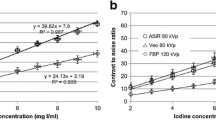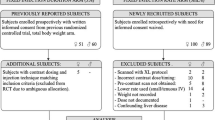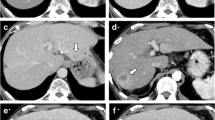Abstract
Objective. To determine an injection protocol for pediatric hepatic CT and to investigate the use of power injection.Materials and methods. Eighty-seven studies were prospectively performed using ioversol (320 mg iodine per cc) at 2 cc/kg. Three techniques were used: helical (1 s/slice); dynamic, non-breath-hold (5.5 s/slice); dynamic, breath-hold (10 s/slice) scans. The liver-scan time for each study was determined. Scan initiation ranged from 25 to 80 s. An injection duration (50–100 seconds) was selected. From the contrast volume (2 cc/kg × kg body wt) and injection duration, the injection rate (cc/s) was calculated for each patient. Each study was grouped by injection rate corrected for body weight (cc/kg/min) into: 1.2–1.5, 1.51–2.0, and 2.01–2.4. The aortic/liver attenuation curves were plotted for each group.Results. Liver-scan time for helical studies was a mean of 26 s, for dynamic, non-breath-hold studies 75 s, dynamic breath-hold scans were 154 s. Injection rates of 1.2–1.5 cc/kg/min produced a scanning interval of 165 s. Injection rates of 1.51–2.0 cc/kg/min produced a scanning interval of 120 s. Injection rates of 2.01–2.4 cc/kg/min produced a scanning interval of 90 s. There was no increase in hepatic attenuation for the injection rates 2.01–2.4 cc/kg/min compared with 1.51–2.0 cc/kg/min. There was one complication related to injection through a central line.Conclusions. An injection protocol was determined for helical studies with injection rates of 1.7–2.0 cc/kg/min with initiation at 60 s; for dynamic, non-breath-hold studies with injection rates of 1.5–1.7 cc/kg/min with initiation at 50 s; and for dynamic breath-hold studies with injection rates of 1.2–1.5 cc/kg/min with initiation at 45 s. Power injection was used safely in our population.
Similar content being viewed by others
References
Cox IH, Foley WD, Hoffman RG (1991) Right window for dynamic hepatic CT. Radiology 181: 18–24
Foley WD (1989) Dynamic hepatic CT. Radiology 170: 617–622
Walkey MM (1991) Dynamic hepatic CT: how many years will it take 'til we learn? Radiology 181: 17–18
Freeny PC (1988) Hepatic CT: state of the art. Radiology 168: 319–323
Berland LL, Lee JY (1988) Comparison of contrast media injection rates and volumes for hepatic dynamic incremented computed tomography. Invest Radiol 23: 918–922
Foley WD, Berland LL, Lawson TL, Smith DF, Thorsen MK (1983) Contrast enhancement technique for dynamic hepatic computed tomography scanning. Radiology 147:797–803
Nelson RC, Chezmar JL, Peterson JE, Bernardino ME (1989) Contrast-enhanced CT of the liver and spleen: comparison of ionic and nonionic contrast agents. AJR 153: 973–976
Kuhns LR (1993) Optimal timing of abdominal CT in children: relationship to injection rate. Radiology 189: 49–51
Cleveland WS (1979) Robust locally weighted regression and smoothing scatterplots. J Am Stat Assoc 74: 829–836
Carlson JE, Hedlund LJ, Trenkner SW, Ritenour R, Halvorsen RA (1992) Safety consideration in the power injection of contrast media via central venous catheters during computed tomographic examinations. Invest Radiol 27: 337–340
McCarthy S, Moss AA (1984) The use of a flow rate injector for contrast-enhanced computed tomography. Radiology 151: 800
Claussen CD, Banzer D, Pfretzschner C, Kalender WA, Schorner W (1984) Bolus geometry and dynamics after intravenous contrast medium injection. Radiology 153: 365–368
Chambers TP, Baron RL, Lush RM, Dodd GD, Miller WJ (1994) Hepatic CTenhancement: comparison of ionic and nonionic contrast agents in the same patients. Radiology 190: 721–725
Author information
Authors and Affiliations
Rights and permissions
About this article
Cite this article
Roche, K.J., Genieser, N.B. & Ambrosino, M.M. Pediatric hepatic CT: An injection protocol. Pediatr Radiol 26, 502–507 (1996). https://doi.org/10.1007/BF01372229
Received:
Accepted:
Issue Date:
DOI: https://doi.org/10.1007/BF01372229




